One of my favorite things to do when friends visit us in Beijing is to take them on a morning walk to look for breakfast. It’s a great way to start the day in Beijing — there’s a buzz in the air as everyone is hurrying off to work and the city comes alive.
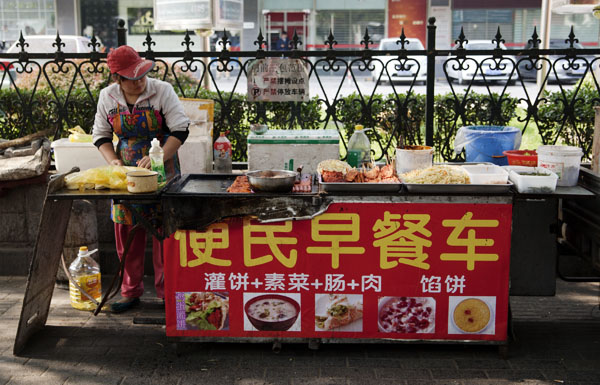
Breakfasts carts abound everywhere, but they are particularly plentiful near subway stops. And if you happen to stumble upon a busy food street, with stalls and hole-in-the-wall restaurants in addition to the carts, then you’ll have your pick of some of the finest Beijing street food.


Like youtiao 油æ¢! Ah, nothing like a mouthful of crispy fried dough in the morning. :) This is a type of Chinese cruller — neither sweet nor savory; just plain satisfying on its own or dunked in something liquidy, be that soy milk, congee (rice porridge), or whatever sauce, soup, or beverage of your liking.


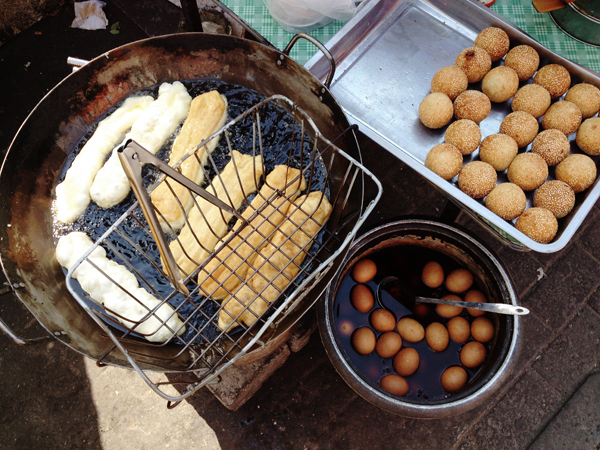
Tea eggs (cha ye dan 茶葉蛋) are also excellent. These hard-boiled eggs have been cracked and marinated in a brew of soy sauce, spices, and tea.

Northern Chinese cuisine features a lot of filling, doughy foods, and breakfast is no exception. There’s mantou 馒头, which is a type of fluffy steamed bread. They can be simply folded or sometimes intricately rolled into many coils or threads, like the so-called yinsijuan 銀絲å·, or silver-thread rolls, which I like to eat strand by strand. :)
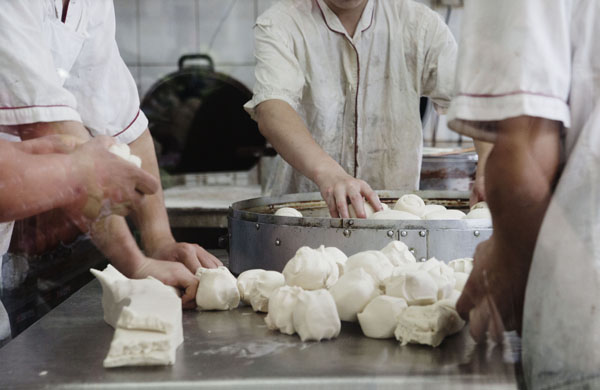

Then there are baozi 包å or buns filled with any number of things, both sweet (like red bean paste) or savory (like pork, cabbage, chives, mushrooms, etc.).


And of course there are jiaozi 餃å or dumplings of all sorts, whether steamed, boiled, or fried.

Indeed, the variations on dough are endless! Like these long, pork-stuffed — buns? dumplings? pancakes? — that are then fried.


If you recognize the dumpling roller above, it is in fact the very same dumpling roller Becca purchased from this vendor as a souvenir right before she left Beijing. :)
Also existing in various permutations is the breakfast sandwich or wrap, like jidan guanbing 鸡蛋çŒé¥¼, which is a sort of egg sandwich. It starts with dough with a smidgen of lard wrapped in the center. Then the dough is rolled flat into a pancake and fried.
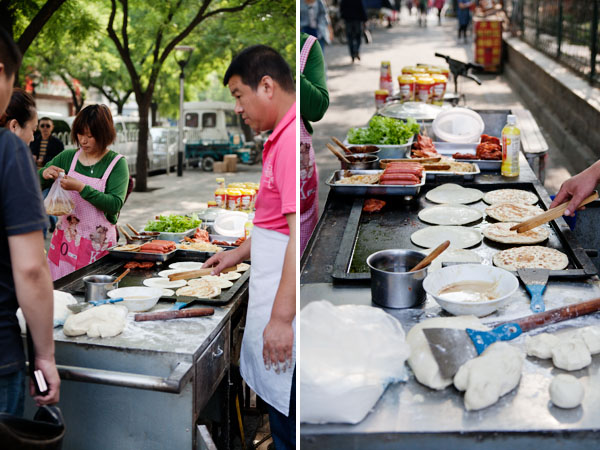 The lard creates a pocket in the center of the pancake that you break open with chopsticks and fill with egg.
The lard creates a pocket in the center of the pancake that you break open with chopsticks and fill with egg.

Once cooked, the pancake is spread with a savory brown sauce and chili sauce, then folded in half like a taco, and stuffed with a piece of lettuce and your choice of filling — shredded potato, hot dog, or chicken or pork.

For lighter fare, if you’re in the mood for tofu in the morning, I highly recommend tofu brains, doufu nao 豆è…è„‘. Or perhaps you might know it as doufu hua 豆è…花, tofu flower or tofu pudding. This dish involves no brains at all but is made up of soft silken tofu that in southern Chinese cultures is served sweet but in many northern Chinese cities is served savory, with soy sauce and various other sauces and garnishes. I have to admit, the taste and quality can really vary from vendor to vendor, and I have yet to find doufu nao that I like here. But I do love silken tofu, so sometimes I just request that all sauces and garnishes be left off so I that can bring it home and add my own.

In a breakfast food category of its own is the perennial fan favorite, the jianbing 煎饼 – affectionately called the “Beijing crepe.” It’s made virtually in the same way as a French crepe, except the batter and filling can vary. The batter below is made of buckwheat flour.
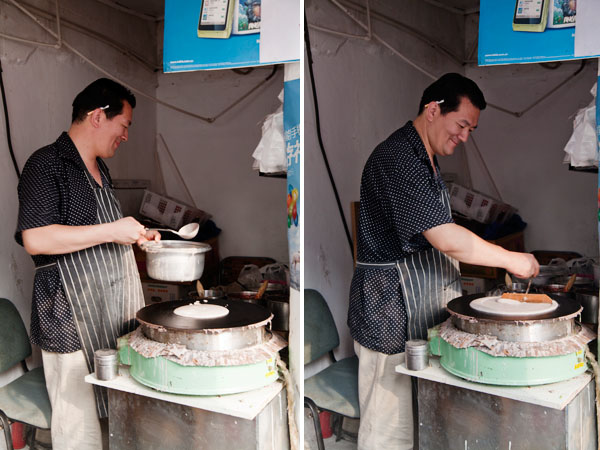
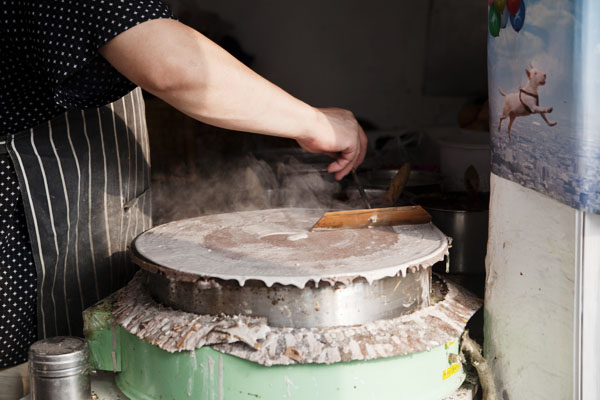
The standard jianbing fillings are egg, a brown hoisin-like sauce, garnishes such as scallions and chili, and a sheet of fried crispy thing that adds a light crunch. For a little extra, you can request another egg or various meat options like hot dog, chicken, or pork.


We used to always get our jianbing from our very own Jolly Crepe Man, who sadly has disappeared from our street for reasons unbeknownst to us. :( As you can see in the photos, he was always smiling. We still believe him to be the jolliest man in all of Beijing.

What might be my favorite thing of all to get on our breakfast street is liangpi 凉皮, a type of Shaanxi noodle made of rice flour and served cold (the name literally means “cold skin”). These noodles are also available at other times of day, not just at breakfast. Sauces and garnishes vary from vendor to vendor, but typically what’s involved is sesame paste, soy sauce, vinegar, and lots of julienned cucumber. The vendor near us also adds garlic, sesame seeds, spongey fried tofu, and cilantro. I absolutely love this dish, especially when the rice noodles are paper thin. It tastes like a Chinese version of Vietnamese banh uot to me!


There are several other popular breakfast items not pictured here. Among them is porridge made from various grains. Rice porridge (zhou ç²¥) is very common in many parts of Asia, but in northern China, millet porridge (å°ç±³ç²¥Â xiaomi zhou) is also common. And soy milk (douzhi 豆æ±) and yogurt (酸奶 suan nai) are drunk at breakfast and throughout the day (yogurt is much more liquid here than we’re used to in the US, as you can imagine if you’re familiar with the sour yogurt drink Yakult).
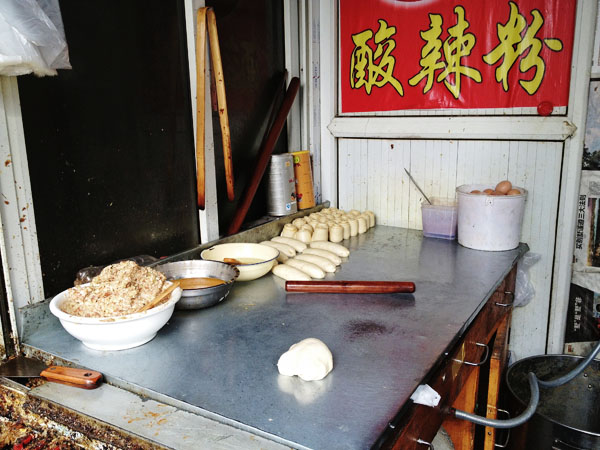
Even though modern buildings and fancy restaurants are constantly popping up all around Beijing, I love how you can get still a feel (and taste :) of old-world Beijing just by going out for a walk in the morning. I hope that never changes.















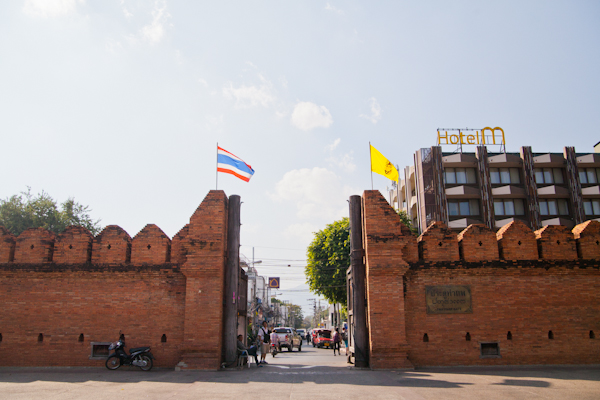



































Connect with us